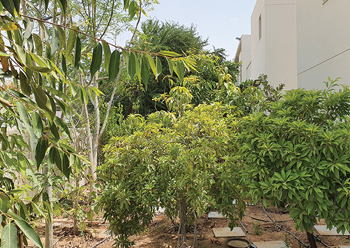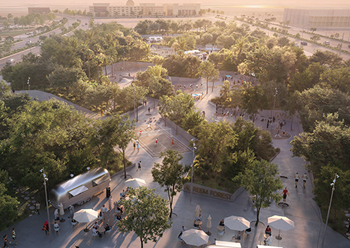
 Breathable sand is a water-retaining and an air-permeable medium, enabling landscapers to grow abundant onsite greenery.
Breathable sand is a water-retaining and an air-permeable medium, enabling landscapers to grow abundant onsite greenery.
We are at an inflection point in the construction industry, with sustainability and wellness taking top priority. Intergovernmental organisations, like the UN, are increasingly advocating for sustainable construction, aimed at meeting the needs of the current generation, without compromising the ability of future generations to meet theirs.
Sustainable construction does not connote compromising on features and facilities; instead, it advocates creating such abundance sustainably. And one such need, which has been amplified due to concerns around holistic wellness following the pandemic, is landscaping.
Lush green surroundings are linked to the overall wellness of residents, and are being seen as a unique value proposition, particularly in multi-family facilities and community-driven developments. This leads to the question: How can we achieve sustainable landscaping in the Middle East, with its desert conditions and water scarcity?
 |
|
Dake ... focus on water-wise urban landscaping. |
Sustainable water use
Many challenges in the Middle East are rooted in water scarcity. Therefore, gardening is usually discouraged, in order to save water for more critical purposes.
However, with the importance of natural greenery being universally acknowledged, the focus is shifting to water-wise landscaping, also known as xeriscaping. This approach aims to create abundant green spaces sustainably, by addressing the gaps associated with conventional, water- and resource-intensive, landscaping – through the use of innovative new technologies.
One notable innovation, which is generating considerable interest among stakeholders across the construction value chain, is breathable sand.
The value proposition of breathable sand – and its affiliated products – is not limited to water-wise landscaping. The technology provides an economically and environmentally viable option, to not only achieve lush urban landscaping, but also harness rainwater and create circularity in the system. In other words, sand technology is about efficient use of available water resources, as well as about creating new sources of water.
In the early construction phase of a building’s lifecycle, this technology provides water for building the infrastructure; and later on for day-to-day community use. In doing so, the breathable sand technology unlocks ongoing value for all stakeholders, and addresses water scarcity.
 |
|
Sand technology is about efficient use of available water resources |
Water-wise landscaping
Breathable sand is a water-retaining and an air-permeable medium, which enables landscapers to grow abundant onsite greenery, while using nearly 80 per cent less water, compared to conventional practices. In addition, the “breathability” function translates to efficient nutrient supply to the plants, enabling optimal yield, with dramatically reduced usage of chemical fertilisers. Landscaping not only becomes water-wise, but it can even be made wholly organic, easily.
And since the product is made from typical aeolian desert sand – which is available in abundance across the Middle East, breathable sand is also an economical option. In fact, the technology addresses virtually all social, economic and environmental concerns around sustainable landscaping, in the Middle East.
The solution can be deployed at any location, any scale, and by individuals and institutions alike. Those yearning for sustainable home gardens, backyards, and balconies, can now create their own private oasis, using significantly less water. At the same time, institutional practitioners can grow large swathes of greenery – in commercial office premises, stadiums, playgrounds, and other public spaces. The cumulative impact of such implementation could lead to a significant offsetting of carbon emissions, while developers can achieve water security in facilities, cater to eco-conscious consumerism, and generate steady ROI (return on investment) as a result.
Harnessing rainwater
The Middle East and North Africa (Mena) is home to 15 out of the 20 of the world’s most water-scarce countries. This scenario calls for multi-stakeholder action, including top-down initiatives from governing bodies; as well as bottom-up efforts from individuals, developers, community officials and administrators and company executives. And any plausible solution must factor in all the social, economic, and environmental implications.
While water scarcity is a systemic issue in the region, so is flooding due to erratic rainfall, cloud-seeding, etc. This dichotomy creates an ideal scenario for the deployment of rainwater harvesting systems, built using water permeable products made from breathable sand. The products – including tiles, pavers and kerb stones – are used to build underground reservoirs of any size, for rainwater harvesting. During rainfall, the surface absorbs rainwater, filters out sediments, and stores the water inside. The built-in “respiratory” function helps keep the water fresh for years, without chemical or electricity based treatment.
Unlike expensive, centralised rainwater harvesting systems – which require periodic maintenance and occupy vast over-ground space – these decentralised systems can be deployed under construction sites, roads, and other public areas; as per convenience and at low cost. In effect, this unlocks dual benefits: Avoiding flooding, and associated damage/repair costs, and harnessing the purest form of water in nature.
By paving with breathable sand products – and with effective sloping and redirection mechanisms – developers can harness huge amounts of rainwater onsite, for community use, landscaping, etc. Surface runoff can also be reused, thereby inducing circularity, in terms of the facility’s water use.
Macro impact
As both urbanisation and population increase, construction will take an even more central role in the world of tomorrow. This is why the construction industry is ripe for critical interventions that can propel it towards a sustainable future, in the opinion of most experts.
If water-wise and sustainable construction is accomplished, the impact will have huge macroeconomic implications. The combination of breathable sand – for water-wise landscaping; and its affiliated products – for rainwater harvesting; is a promising solution that aligns with the 3Rs of ‘reducing, reusing, and recycling’, water. When scaled from communities to clusters, these solutions could be a game-changer for the development of cities that are sustainable, healthy, and abundant in their green cover.
* Dake Rechsand’s breakthrough breathable sand technology utilises low-value desert aeolian sand, to create a constantly evolving portfolio of high-value products.








.jpg)




.jpg)




























.jpg)



































